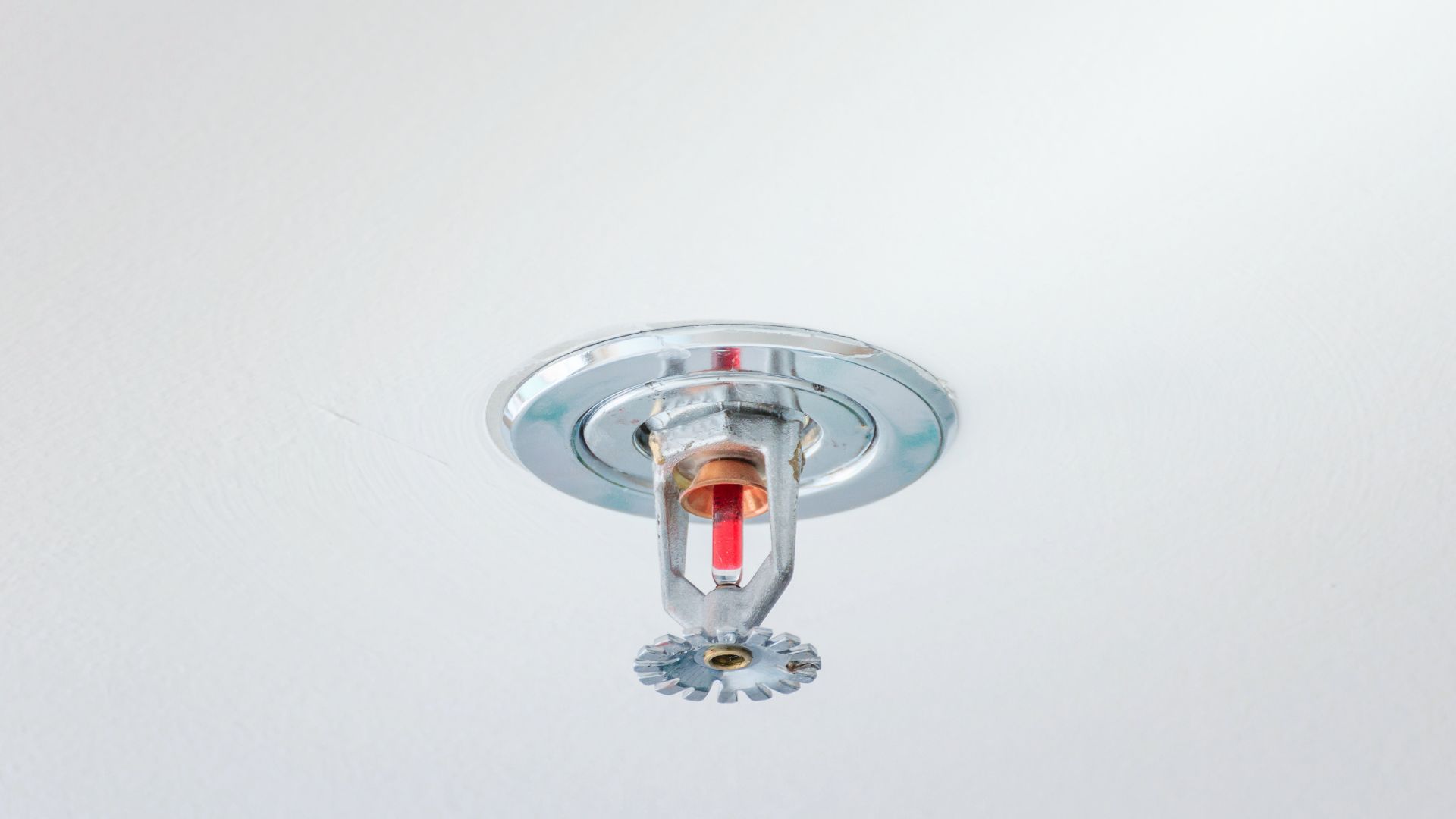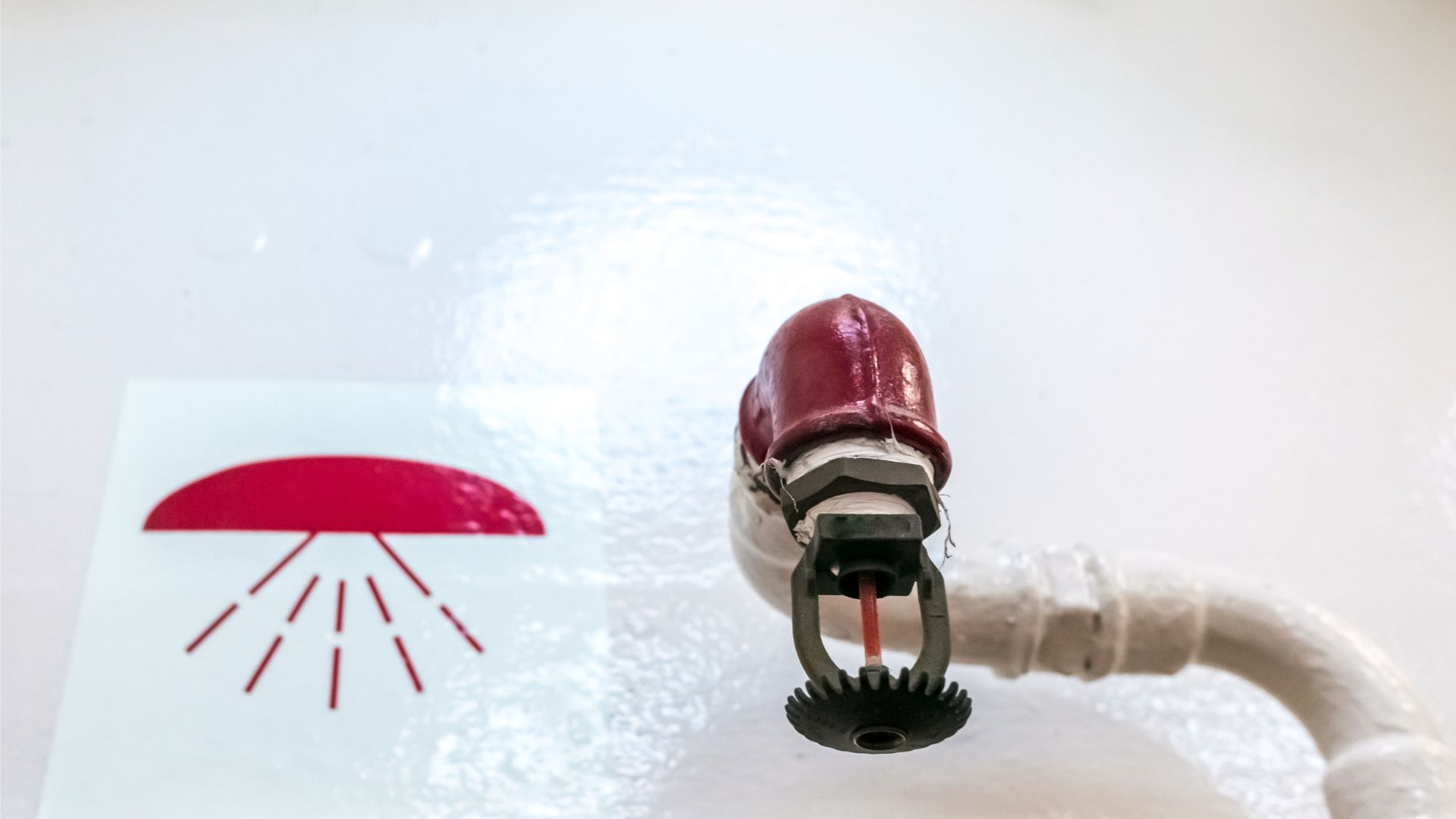Industrial fire sprinkler systems are essential for safeguarding commercial and industrial spaces from fire risks. They provide reliable protection, crucial for maintaining safety standards. Without these systems, businesses face severe consequences, including potential loss of lives, extensive property damage, and disruptions.
Fire sprinkler systems work by detecting heat and releasing water to tackle fires, dramatically cutting down potential damage. They can reduce property loss and threats to life by over 65%. Their quick response is vital for protecting people and assets.
Also, sprinklers use six times less water than a fire hose, making them an efficient choice. Sprinkler systems are designed to cover large areas, providing comprehensive protection across various facility types.

Installing a fire sprinkler system is a proactive way to protect your business. These systems can notably lessen fire impacts, providing peace of mind. Investing in well-maintained sprinkler systems is crucial for any conscientious business owner. We’ll delve into various aspects, like types, installation tips, and compliance factors.
Types of Fire Sprinkler Systems
Industrial fire sprinkler systems are vital for ensuring safety in various settings. Understanding the different types of fire protection systems can help you choose the best option for your needs.
Wet Pipe Systems
Wet pipe systems are the most common type of fire protection systems. They contain water in the pipes at all times and are ready to discharge when fire detection occurs. This ensures rapid response and is ideal for environments where freezing is not a concern.
Dry Pipe Systems
Dry pipe systems are filled with pressurised air. Water is held back until detected, making it suitable for cold environments where pipes might freeze. They offer excellent fire suppression without the risk of pipe damage due to freezing.
Pre-Action Systems
Before releasing water, pre-action systems require two triggers: fire detection and a secondary activation. This feature prevents accidental discharge, making them ideal for protecting sensitive equipment or valuable assets.
Deluge Systems
Deluge systems feature open sprinkler heads connected to a water supply through a valve. When activated, they release water simultaneously from all heads, providing comprehensive coverage. This is particularly effective for high-hazard areas requiring rapid suppression systems.
Picking the right fire sprinkler system is key to effectively safeguarding your facility. Each type offers specific benefits tailored to different applications, ensuring complete safety for your setup.
How Fire Sprinkler Systems Work
Understanding how fire sprinkler systems work is essential for adequate fire protection. These systems are composed of several vital components that work together seamlessly.
- Sprinkler Heads: Sprinkler heads are crucial elements of fire sprinkler systems. They are strategically placed to ensure optimal coverage. When a fire is detected, the heat causes the sprinkler heads to activate, releasing water to suppress the flames.
- Piping and Water Supply: The piping network is always filled with water or air, depending on the system type. It connects sprinkler heads to a reliable water supply, ensuring immediate response when needed. The water supply is critical for maintaining constant readiness.
- Fire Detection Systems: Fire detection systems are essential in identifying fires early. They trigger the sprinkler system, initiating the suppression process. These systems are sensitive to heat, smoke, or other fire indicators.
- Alarm Systems: Alarm systems are integrated to alert occupants and emergency services. They activate when the fire sprinklers engage, ensuring a swift response to the fire.
Pre-Installation Considerations
Planning a fire sprinkler system installation involves several crucial steps to ensure effectiveness and compliance.
Risk Assessment
The first step is conducting a comprehensive risk assessment. This evaluation evaluates potential fire hazards and determines your business’s specific needs. It informs the overall design and installation, ensuring the system is tailored to your facility’s requirements.
Structural Integrity
Ensure that walls and ceilings can support the weight, and install sprinkler systems to help prevent structural issues. This evaluation is critical to preparing your site for system design installation.
Water Supply Needs
The chosen protection systems must have access to a reliable water source to function effectively. Calculating the required water pressure and flow ensures your fire sprinkler system operates efficiently in an emergency.
Identifying Challenges
Consider obstacles such as existing fire extinguishers, electrical systems, and emergency warning devices that might interfere with the installation process. Addressing these challenges early can streamline the installation.
Obtaining Permits
Obtaining necessary permits is a legal requirement for installing fire protection systems. Liaising with local authorities and fire services ensures compliance with regulations. Proper licenses are crucial for avoiding legal complications and installing systems without issues.
Planning for Life Safety
Incorporating life safety measures into your planning is crucial. Your fire sprinkler system should complement other safety features, such as annual fire safety checks and emergency protocols. This ensures a holistic approach to safety in your business environment.
Building Codes and Compliance Standards
Adhering to building codes and compliance standards is crucial when installing industrial fire sprinkler systems. This ensures safety and effectiveness.
Australian Standards
At the core of these regulations in Australia is AS 2118. This national standard outlines the requirements for designing, installing, and maintaining fire sprinkler systems in various buildings. It covers everything from system design criteria and water supply requirements to component specifications and installation procedures.
Compliance Requirements
Fire systems compliance involves more than just national standards. Depending on your facility’s location, you may also need to follow local or state-specific regulations. These can include additional design requirements, installation procedures, or maintenance schedules. Ensuring IV fire systems compliance is essential to meet these diverse standards.
Certification and Training
Having a Certificate IV in fire systems is valuable for professionals. It provides in-depth knowledge of system design, installation, and maintenance, ensuring that your systems are effective and legally compliant.
Following these standards and obtaining the necessary certifications, like the Certificate IV fire systems, helps ensure your facility’s and its inhabitants’ safety and protection.
Risk Assessment and System Design

A comprehensive risk assessment is vital in crafting the right fire sprinkler system for your facility. Begin by considering factors like the facility’s size, occupancy type, fire hazards, and water availability. Each element shapes a system tailored to your building’s needs.
For instance, more significant buildings might need more extensive coverage, while the type of occupancy—a warehouse, office, or manufacturing plant—can require different safety measures. Understanding specific fire risks, such as flammable materials or high-temperature operations, is crucial for crafting an effective system. Plus, the water supply has to support the system’s demands during an emergency.
Involving qualified professionals in the assessment and design process is vital. Their expertise ensures that the system meets safety standards and regulations. With their help, you can design a system that provides optimal protection and strengthens the facility’s overall safety strategy. Businesses can achieve reliable fire protection by focusing on a detailed risk assessment and professional input.
Choosing the Right System and Components
Begin with a thorough risk assessment to identify your space’s hazards and requirements. The system type—wet, dry, pre-action, or deluge—should align with the environmental conditions and level of protection needed.
For example, wet systems are ideal for buildings with consistent temperatures, while dry systems are better for unheated environments. Pre-action systems are suitable for areas where accidental discharge could be damaging, and deluge systems are used in high-risk areas needing rapid water delivery.
Sprinkler head selection is another critical factor. Options include pendent, upright, sidewall, and concealed heads designed for different coverage and aesthetic needs. Ensure the chosen heads match the ceiling height and potential fire load.
Piping materials such as steel, copper, or CPVC should be selected based on durability, cost, and compatibility with the building’s infrastructure. When making your choice, consider local codes and regulations.
Lastly, ensure the water supply is reliable and sufficient to meet the system’s demands. This may involve evaluating existing water sources or installing a dedicated water storage system. Consulting with fire protection professionals can provide additional insights and tailored recommendations for your needs.
A Comprehensive Guide to Installation
This section offers a detailed look at installing industrial fire sprinkler systems. Sticking to the correct procedures and codes is crucial for making sure the system works effectively and stays compliant.
Site Preparation and Planning
Getting the site ready is a vital step before installation.
First, secure all necessary permits to comply with local rules. Coordinate with different trades, such as electricians and plumbers, to ensure everyone’s schedules align and avoid clashes.
Clear access to the site is essential, so plan delivery routes and where materials will be stored. Safety should be a top priority—set up safety measures and assess risks.
Good planning helps prevent disruptions by anticipating and addressing potential issues early on. This approach keeps the project on track and within budget.
Effective communication among everyone involved is critical to quickly resolving any problems. Focusing on thorough preparation sets the stage for a smooth and successful project.
Step-by-Step Installation Process
Installing a fire sprinkler system involves several critical steps to ensure safety and functionality:
1. Planning and Layout
- Assess Requirements: Determine the coverage area and specific needs based on building codes and regulations.
- Design Layout: Create a detailed schematic of the piping network and sprinkler head locations.
2. Installing the Piping System
- Materials: Use approved materials like steel or CPVC pipes.
- Pipe Cutting and Threading: Measure, cut, and thread pipes according to the design plan.
- Hanging Pipes: Secure pipes using hangers and supports, ensuring proper spacing and alignment.
3. Installing Sprinkler Components
- Sprinkler Heads: Install heads at designated points. Ensure they are the correct type for the environment (e.g., pendant, upright).
- Valves and Gauges: Attach control valves and pressure gauges for monitoring and maintenance.
4. Connecting Water Supply and Alarms
- Water Supply: Connect the system to the main water supply. Install backflow preventers to protect water quality.
- Alarm Integration: Connect the system to fire alarms for automatic alerts in case of activation.
5. Testing the System
- Pressure Testing: Conduct hydrostatic tests to check for leaks and ensure pressure stability.
- Operational Test: Simulate activation to verify the functionality of sprinkler heads and alarms.
6. Addressing Clearances and Regulations
- Clearance Checks: Ensure there are no obstructions around sprinkler heads.
- Compliance: Verify that the installation meets local fire safety codes and standards.
Using diagrams to illustrate the piping layout and sprinkler head placement can significantly enhance understanding and accuracy during installation.
Testing and Commissioning
Thorough testing and commissioning are crucial for ensuring fire systems function correctly and comply with Building Code Australia. A well-designed fire sprinkler system layout and fire equipment, including fire pumps, are essential fire safety components in any industrial fire scenario.
Testing procedures, such as hydrostatic pressure tests, flow tests, and alarm tests, verify the integrity and performance of your system. Hydrostatic pressure tests confirm the durability of pipes, while flow tests ensure that fire pumps and sprinklers deliver adequate water supply. Alarm tests ascertain that warning systems activate promptly during emergencies.
Acceptance criteria must meet specific unit competency standards, ensuring fire systems operate effectively under various conditions. Documentation is critical to this process, providing a compliance record and future reference for maintenance fire procedures.
Commercial or industrial plumbers provide detailed reports demonstrating adherence to these standards, which is essential for ongoing safety and regulatory compliance. Regular testing and maintenance of fire systems are mandatory to uphold essential fire safety, protecting both property and lives.
Ensuring Compliance with AS 2118
Complying with AS 2118 is crucial for designing, installing, and maintaining fire sprinkler systems. This standard is vital for ensuring safety systems in commercial buildings. Installing automatic fire sprinklers according to AS 2118 helps maintain effective safety measures. Essential requirements include proper installation techniques and adherence to the building code, critical for preventing hazards.
Non-compliance can have serious consequences, including legal implications and increased safety risks. Using the correct type of fire system, such as gas suppression, is essential for different environments. The 11002NAT Certificate IV provides the necessary training to ensure compliance and competence. Failure to install fire systems correctly can compromise the entire safety framework, highlighting the importance of meeting every aspect of AS 2118.
Mandatory Inspections and Certifications
Mandatory inspections and certifications are critical for ensuring the integrity and compliance of fire safety systems. Organisations adhering to national standards and regulations provide certifications for industrial sprinklers and fire safety.
Regular inspections by qualified personnel help maintain system integrity and legal compliance and protect property and lives by keeping all safety measures up-to-date. Institutions like TAFE Queensland offer Certificate III in Fire Protection courses, equipping individuals with the technical skills to install, test, and maintain fire protection systems.
Training.gov.au lists various qualifications, including Certificate III in Fire Protection and Certificate IV in Fire Systems Compliance, to develop competencies in fire protection systems. The National Fire Industry Association (NFIA) provides entry-level courses like the Certificate II in Fire Protection Inspection and Testing, which is a starting point for a career in the fire protection industry. These certifications ensure individuals and businesses are well-equipped to handle fire safety and comply with legal requirements.
Documentation and Record-Keeping
Proper documentation and record-keeping are vital during the installation and maintenance of fire safety systems. Key documents include design drawings, installation records, test reports, and maintenance logs. These records ensure standards compliance and simplify troubleshooting by providing a clear system history.
Accurate documentation helps identify potential issues early and ensures that all safety measures are consistently met. Keeping detailed records is essential for both legal compliance and maintaining the integrity of the system, ultimately ensuring safety and reliability in the long term.
Post-Installation Maintenance and Checks
This guide outlines ongoing maintenance for fire sprinkler systems. Regular maintenance is crucial to ensure effectiveness and compliance with safety standards.
Regular Maintenance Schedule
A detailed maintenance schedule is essential for the reliability of fire sprinkler systems. Recommended activities include:
- Visual Inspections: Check for leaks, corrosion, and obstructions.
- Flow Tests: Verify adequate water supply and pressure.
- Alarm Tests: Ensure alarms trigger correctly.
- Replacements and Adjustments: Update worn parts and adjust settings as needed.
Importance of Professional Maintenance
Professional maintenance services offer expertise and specialised equipment. Knowledge of these specialised allows professionals to identify and address potential issues, ensuring your system remains compliant and effective. Their expertise ensures thorough inspections and timely interventions, maintaining optimal performance.

Emergency Planning and Staff Training
This section guides you through emergency planning and training, highlighting the importance of preparedness and effective emergency response.
Developing an Emergency Response Plan
An effective emergency response plan includes:
- Evacuation Procedures: Clear, accessible routes for safe exits.
- Assembly Areas: Designated safe spots for gathering.
- Communication Protocols: Reliable systems for alerts and updates.
- Coordination with Emergency Services: Seamless integration with local responders.
Training Staff on Fire Safety Procedures
Comprehensive fire safety training is crucial for staff. Key topics include:
- Prevention Measures: Identifying and reducing risks.
- Extinguisher Use: Correct handling and operation.
- Evacuation Procedures: Efficient and safe exits.
- Sprinkler System Operation: Basic understanding of system functions.
Secure Your Business with Expert Sprinkler Solutions
Installing and maintaining industrial fire sprinkler systems cannot be overstated. These systems are critical components safeguarding facilities, ensuring compliance with safety regulations, and protecting personnel and assets from potential fire hazards. Proper installation and maintenance are essential to the effectiveness and reliability of these systems. By choosing the right professionals, businesses can have peace of mind knowing that their fire safety measures are in expert hands.
Big Blue Plumbing is the premier choice for commercial plumbing services across the Sunshine Coast and Moreton Bay. With a team of experienced professionals, we specialise in installing and maintaining commercial sprinkler systems, ensuring that your business remains compliant and secure. Whether you need a new system installed or routine maintenance for existing sprinklers, Big Blue Plumbing offers expertise and reliability. You can easily reach out via phone, email, or by visiting our website. Contact Big Blue Plumbing for all your industrial fire safety needs.



